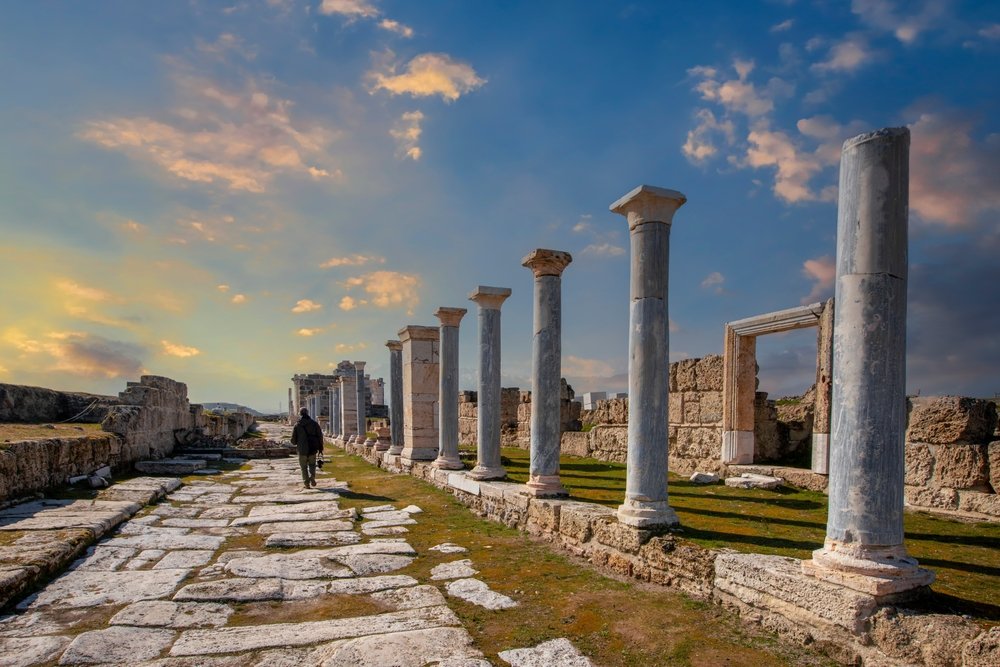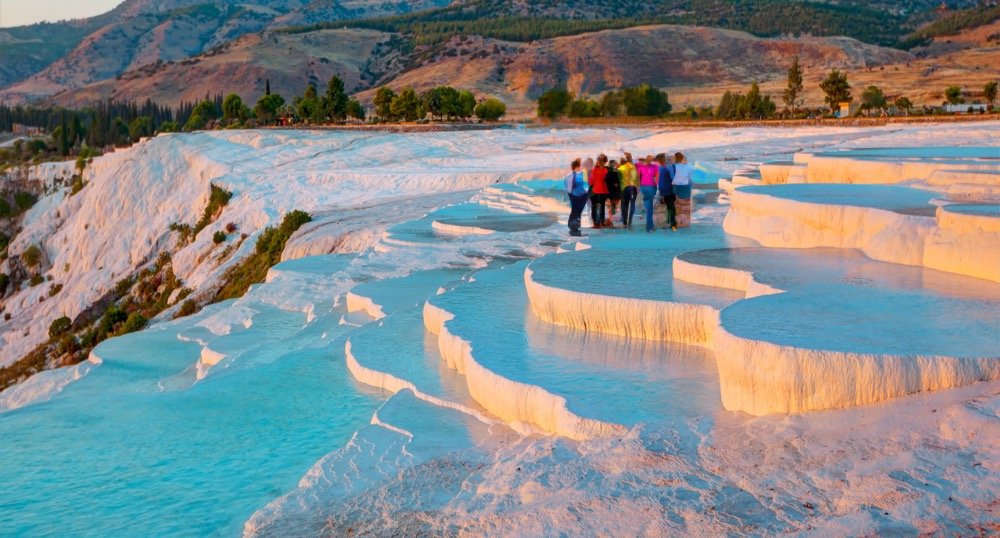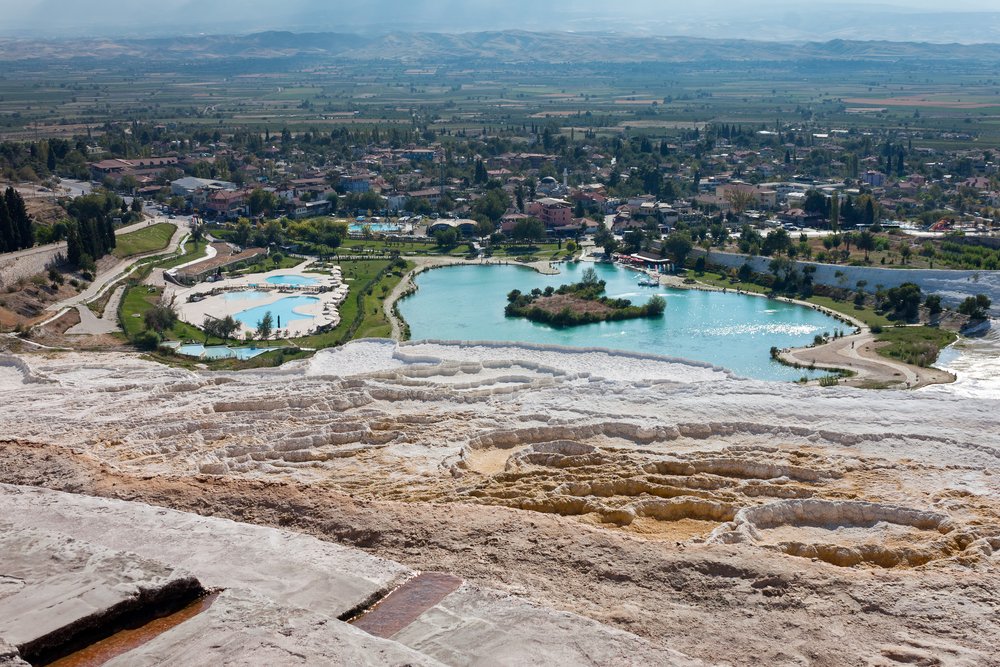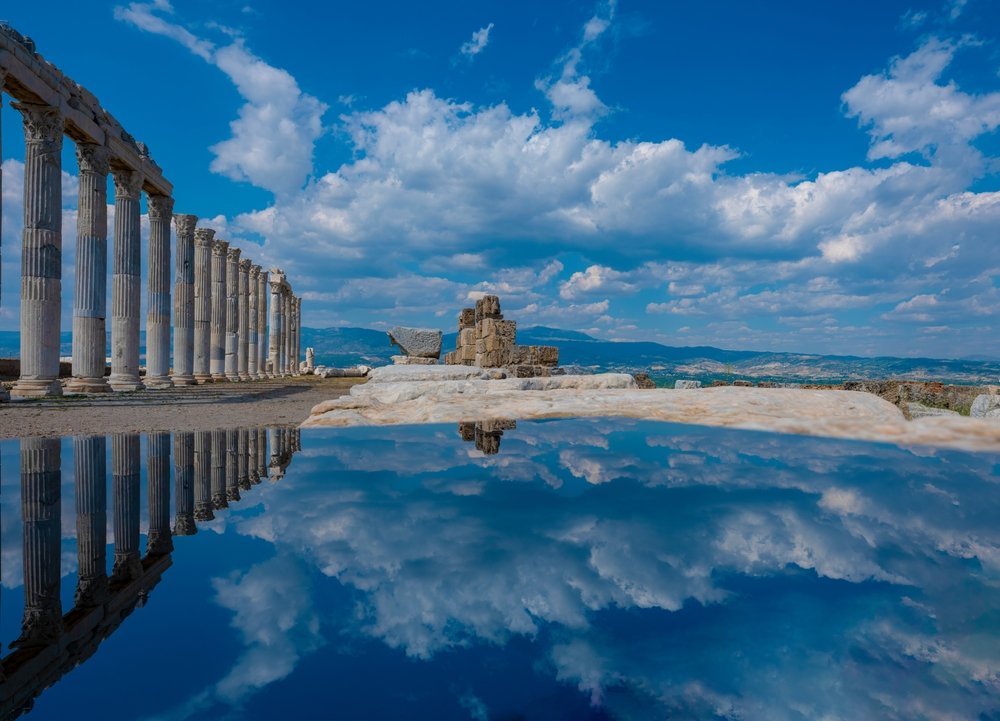PAMUKKALE
Tours from Antalya, Bodrum & Istanbul
Bestseller Pamukkale Tickets
Pamukkale and Hierapolis Ancient City Ticket & Audio Guide
Bestseller Ticket
Explore the ancient city of Hierapolis and the stunning white travertines of Pamukkale with this entry ticket, complete with an audio guide. Discover fascinating ruins, relaxing thermal pools, and the extraordinary natural wonders of this UNESCO World Heritage Site. + more details
Pamukkale City Highlights Tour with Lunch & Hotel Transfers
Bestseller Tour
Explore the ancient Roman spa city of Pamukkale on a guided tour with transfers. Discover the red hot springs of Karahayit, marvel at white travertine terraces, and see the ruins of Hierapolis. Marvel at the beauty of this UNESCO World Heritage site. + more details
Discover the stunning white terraces formed by thermal waters and explore the ancient ruins of Hierapolis. This tour includes lunch and hotel transfers but does not cover entrance fees to Pamukkale, Hierapolis, or Cleopatra's Pool. (available for an extra fee) + more details
Explore the natural wonders and ancient history on this full-day tour from Antalya to Pamukkale, including entrance fees (€30) to Pamukkale and Hierapolis. This tour offers the convenience of hotel pick-up and drop-off, a delicious breakfast, a delightful lunch, and an enriching experience at two of Turkey’s most famous attractions. + more details
Travel from Antalya to the “Cotton Palace” of Pamukkale and the ancient city of Hierapolis, on a full-day guided tour. Visit the Apollo temple, the Roman baths, the agora and other sites. Enjoy lunch and a swim in the soothing thermal waters. + more details
Explore the natural wonders and ancient history on this full-day tour from Antalya to Pamukkale. This tour including entrance fees to Pamukkale and Hierapolis, hotel pick-up and drop-off, breakfast, lunch, and an enriching experience at two of Turkey’s most famous attractions + more details
Visit Pamukkale's thermal springs, framed by the otherworldly beauty of natural calcium terraces. Explore the ancient city of Hierapolis on a small group tour and enjoy lunch in a unique setting. + more details
Discover the Cotton Castle of Turkey on this exclusive private day tour. Departing from Istanbul, this trip is perfect for those who wish to experience the magic of Pamukkale but are short on time. + more details
Visit Pamukkale on this private tour from Istanbul with Round-trip domestic flight tickets between Istanbul and Denizli. + more details
Explore Turkey's UNESCO World Heritage Sites with a skilled pilot. Tandem paragliding is a thrilling way to see the beautiful landscape of Pamukkale from above. + more details
Soar above the stunning white terraces of Pamukkale on a breathtaking hot air balloon ride, taking in panoramic views of this natural wonder at sunrise. + more details
Best Combo Ticket For Pamukkale
Explore Turkey's UNESCO World Heritage Sites on a 2-day tour with return flights from Istanbul. Visit Ancient Ephesus, the House of Virgin Mary, the Temple of Artemis, Hierapolis, and Pamukkale. + more details
How to Get to Pamukkale, Turkey
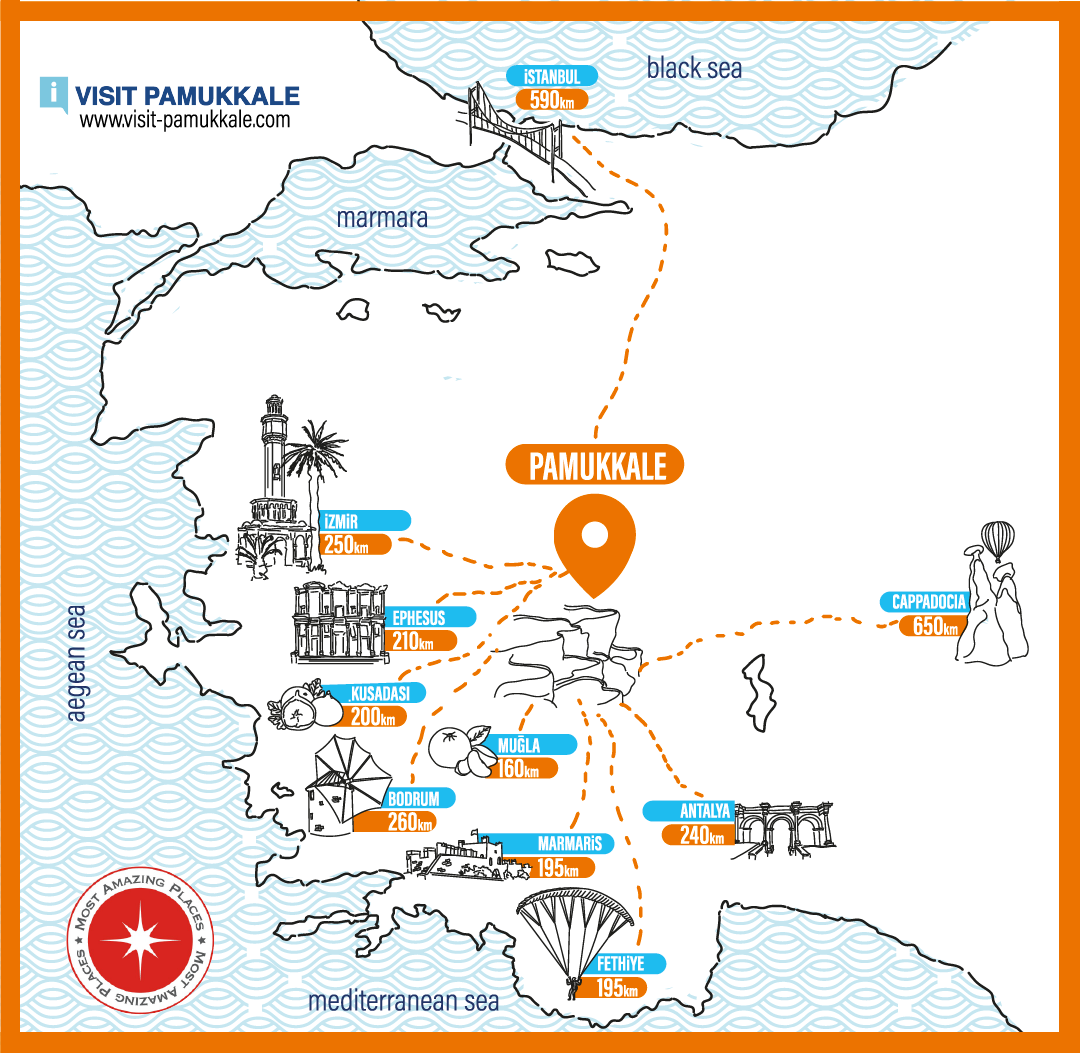
Where is Pamukkale?: Pamukkale is located in southwestern Turkey, in the Denizli Province. It is famous for its unique white travertine terraces and ancient ruins, including the Roman spa city of Hierapolis.
Getting to Pamukkale from Istanbul: Pamukkale is easily accessible from Istanbul. You can take a direct flight to Denizli-Çardak Airport, about an hour away. From airport, it's an hour's drive to Pamukkale. Alternatively, you can drive from Istanbul, which takes approximately 7-8 hours.
Getting to Pamukkale from Izmir: From Izmir, you can take a direct bus (4 hours) or drive (3 hours). Train options are available but longer.
Getting to Pamukkale from Antalya: Pamukkale is accessible from Antalya by bus (4 hours) or driving (3.5 hours). Both options provide a scenic route through the region.
From Denizli: The best way to reach Pamukkale is by using local transport options. It takes about 20 minutes to get there from the centre of Denizli. Regular minibuses (dolmuş) leave from the Denizli bus stop and take you to the site quickly and cheaply.
When you arrive in Pamukkale, you'll notice the stunning white terraces formed by thermal waters rich in calcium. It's a one-of-a-kind experience to walk on these decks and soak in the thermal pools. With its well-preserved Roman Theatre, large Necropolis, and famous Cleopatra's Pool, the nearby old city of Hierapolis adds a historical touch to your trip.
Highlights of the Pamukkale Complex:
- Travertine Terraces: Walk barefoot on the striking white terraces and bathe in the thermal waters.
- Hierapolis: Explore ancient ruins, including the impressive Roman Theatre and the expansive Necropolis.
- Cleopatra’s Pool: Enjoy a swim in this thermal pool surrounded by submerged ancient columns.
Pamukkale’s unique combination of natural wonders and historical sites makes it an unforgettable destination in Turkey.
>> Learn the transportation ways to get to Pamukkale
Discover Pamukkale
Pamukkale, meaning "Cotton Castle," is located in southwestern Turkey and known for its natural beauty, featuring snow-white travertine terraces, and a rich history showcased through the ruins of the ancient city of Hierapolis.Hierapolis, founded by King Eumenes II in the 2nd century BCE, prospered with its therapeutic thermal springs. Roman, Byzantine, and Seljuk influences made it a major spa town.
The magnificent white terraces, formed by calcium-rich hot springs, are a sight to behold. Travertine deposits form as 17 hot springs with temperatures between 35°C and 100°C run down the mountainside. These natural processes have shaped the unique cascading terraces and thermal pools of warm, mineral-rich water.
The historical and therapeutic appeal of Pamukkale and Hierapolis, UNESCO World Heritage Sites, attracts visitors from around the world. To protect this unique geological feature from environmental and tourism issues, preservation is essential. The combination of natural beauty and rich history makes Pamukkale an irresistible destination.
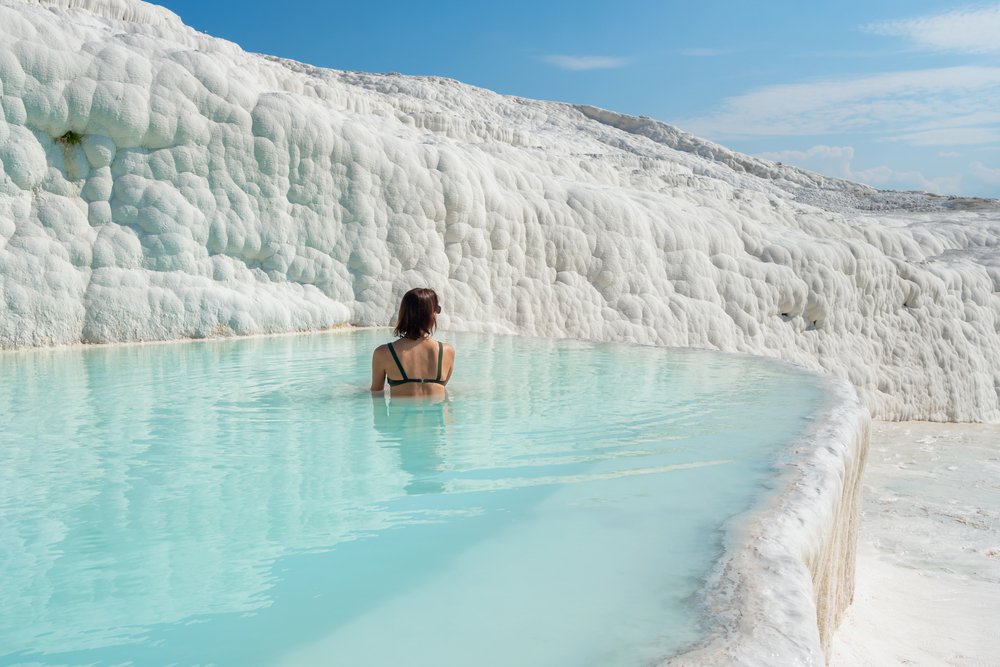
6 Reasons to Visit Pamukkale
1. Unique Natural Beauty: Pamukkale's mineral-rich thermal waters produce magnificent white travertine terraces, creating a dreamlike environment and photo opportunities unlike any other.
2. The Ancient Ruins of Hierapolis: Hierapolis' well-preserved magnificent theatre, Roman baths, temples, and necropolis offer a comprehensive historical experience.
3. Therapeutic Thermal Springs: People have used the warm, mineral-rich waters of Pamukkale's thermal springs for medical purposes since ancient times.
4. UNESCO World Heritage Site: The UNESCO World Heritage Site of Pamukkale and Hierapolis preserves their global worth for future generations.
5. Stunning Sunset Views: The white travertine terraces glow pink and orange during sunsets, creating a beautiful and unique spectacle.
6. The Hierapolis Theatre: Hierapolis is one of the best-preserved Roman theatres. It seats approximately 12,000 people and has wonderful countryside views.
>> Click here for more detailed information about Pamukkale.
Highlights & Attractions of Pamukkale

Travertine Terraces
Pamukkale's crown jewel is the white travertine terraces.
These terraces resemble frozen waterfalls and create a stunning lunar environment formed by mineral-rich hot springs over millennia.
Visitors can wander barefoot on designated trails among the thermal pools to admire the natural magnificence.
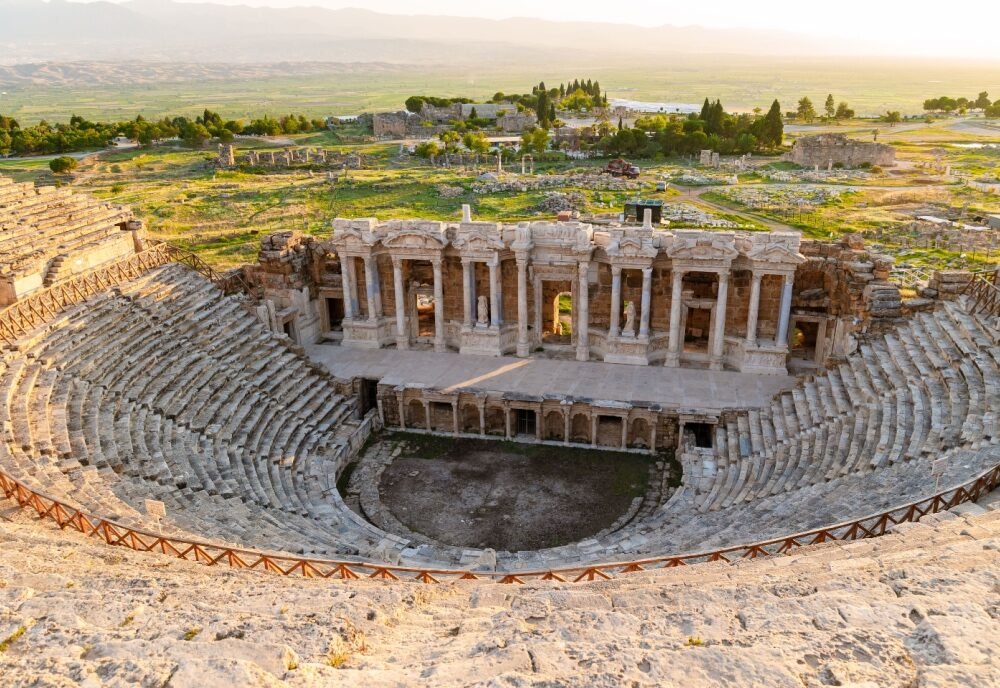
Hierapolis, the Ancient City
The ancient city of Hierapolis, which was built in the 2nd century BC, is situated on white terraces. It is a mystery.
The ruins of Greco-Roman civilisation include locations such as the Theatre, the Temple of Apollo, and Pluto Gate, a mystery grotto that is believed to be the gateway to the underworld.
Exploring these ruins offers a captivating journey through history.
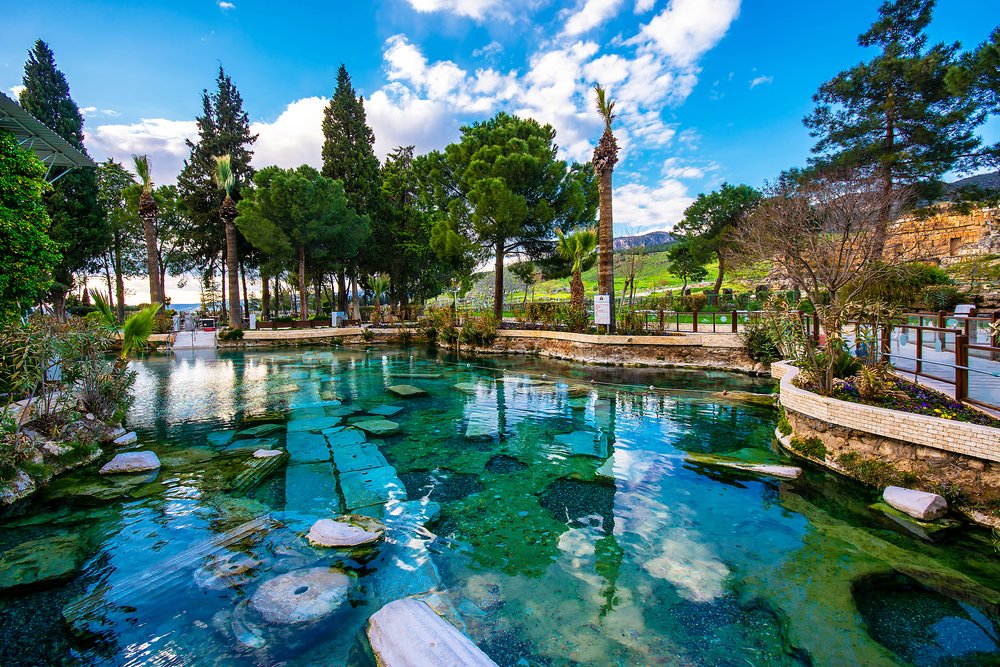
Cleopatra's Pool
Cleopatra's Pool has warm, mineral-rich water that will take you back in time.
This ancient Roman spa, originally built as part of the Hierapolis complex, is thought to have been a favourite place of the Egyptian queen.
The Cleopatra's Pool Thermal Bath is open and a unique place to swim, while the main pool is closed for preservation.
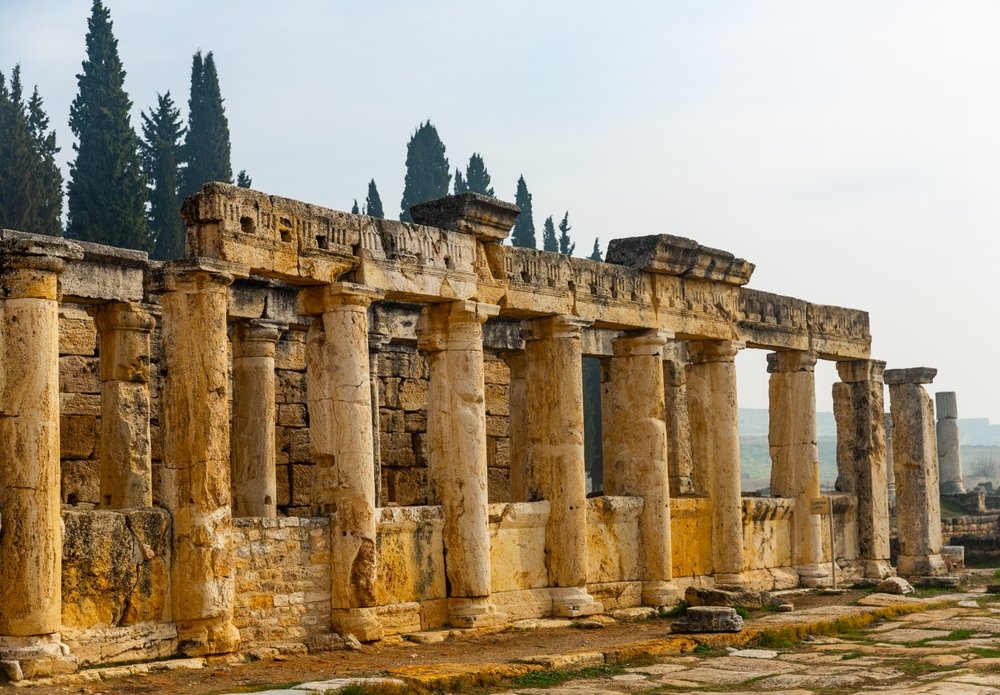
Hierapolis Archaeology Museum
The mission of the Hierapolis Archaeology Museum is to explore the history of Hierapolis and its surrounding region.Its vast collection includes sculptures, mosaics, and sarcophagi, among other artefacts unearthed in the ancient city.
This museum offers a fascinating glimpse into the rich cultural and historical heritage of the area, showcasing the impressive artistry and craftsmanship of past civilisations.
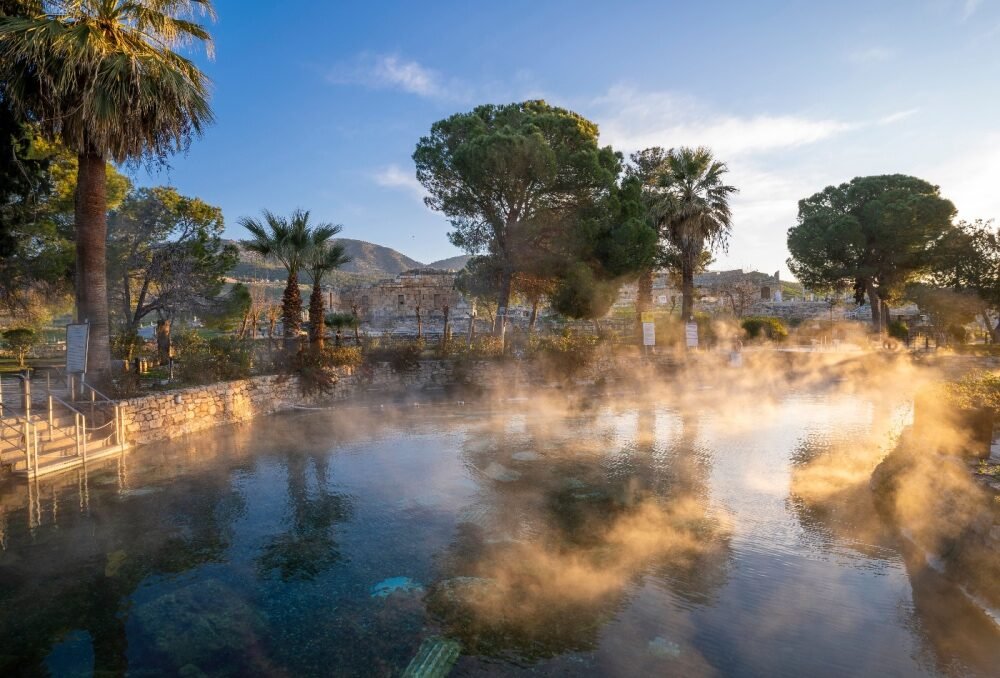
Pamukkale Thermal Pools
Pamukkale's thermal pools have been used therapeutically for generations. They are believed to have healing effects on rheumatism, cardiovascular diseases, skin diseases, and more.
To safeguard the natural hot springs, tourists can only bathe in a few pools in a designated area and no longer bathe in the travertine pools, but they can still soak in the mineral-rich Karahayit Hot Springs near Pamukkale, which are therapeutic.
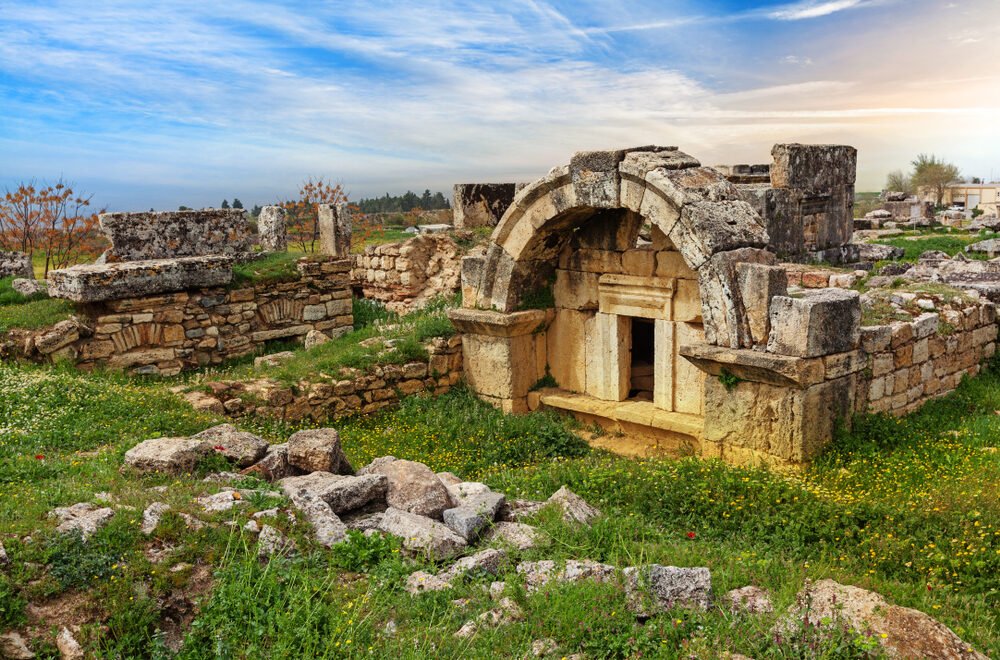
The Necropolis
The Necropolis of Hierapolis is one of Turkey's largest and best-preserved ancient cemeteries.
It has about 1,200 tombs, from simple burials to ornate family mausoleums, over 2 kilometres long.
Ancient Hierapolis' burial habits and social systems are shown by its tombs.
Various sarcophagi, inscriptions, and tomb markers reveal insight into the lives of the people who lived in this ancient city.
Should I Buy my Pamukkale Ticket on-site or online?
Pamukkale is one of Turkey’s most breathtaking natural wonders, and visiting requires an entry ticket costing 30€ for foreign tourists. Due to its popularity, the site can get crowded, making it important to plan ahead for a smooth experience.
Here are a few reasons why you should buy your Pamukkale entry ticket online:
While general admission lets you explore Pamukkale independently, booking a guided tour online is a great way to learn about its fascinating history and natural wonders. Many tours also include transportation from cities like Denizli, Antalya and even Istanbul, making your visit even more convenient.
Plan Your Visit to Pamukkale
Opening Hours of Pamukkale
(On Foot) Northern Door: 08.00 - 21.00
South Door: 06.00 - 23.00
Ancient Pool (Thermal Pool): 08.00 - 20.00
Hierapolis Archaeological Museum: 08.00 - 20.00
Laodicea: 08.00 - 21.00
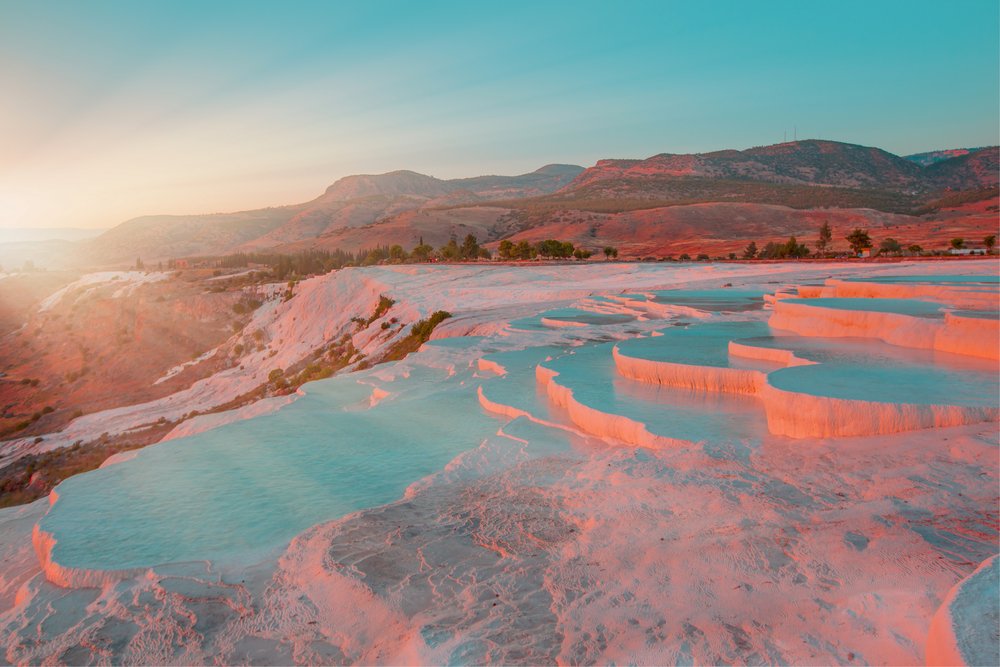
Things to Know Before Visiting the Pamukkale
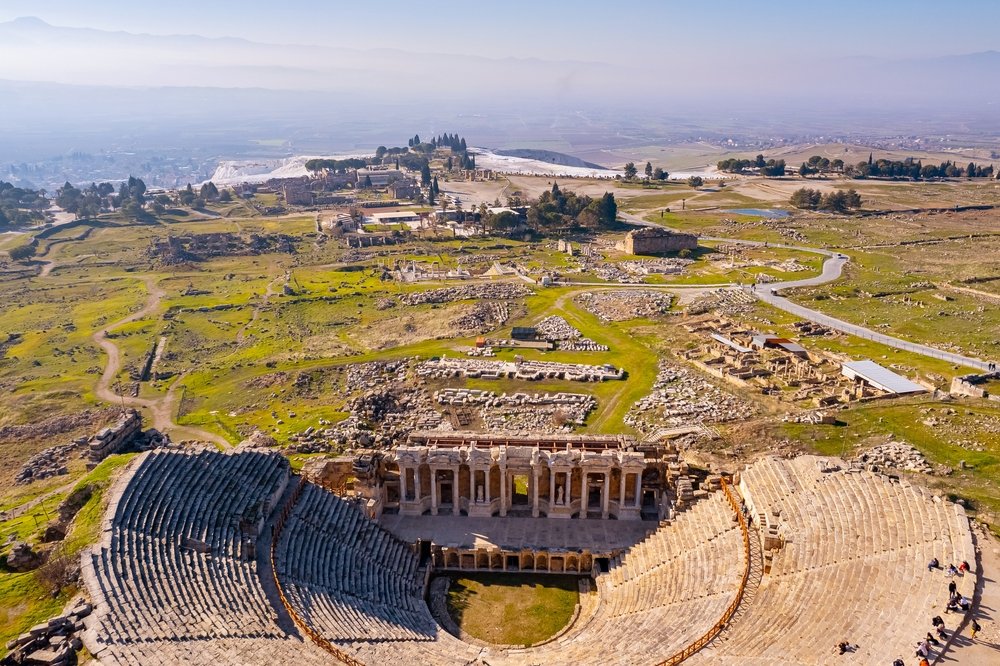
Do I Need a Guided Tour to Visit Pamukkale ?
It's truly magical to explore Pamukkale, which is full of beautiful natural sights and interesting historical places. If you opt for a day trip, you will have your tour guide to show you around.
You could just walk around on your own, but there are some great reasons to join a guided tour:
You can enjoy Pamukkale on your own; however, a guided tour is more interesting, hassle-free, and full of interesting things to do. It's like having a storyteller, historian, and friend from the area all in one. It will make your trip truly memorable.
Frequently Asked Questions About Pamukkale and Hierapolis
Pamukkale, a natural site in southwestern Turkey, is famous for its white travertine terraces formed by mineral-rich thermal waters.
Hierapolis, founded in the 2nd century BC, was an ancient spa city known for its therapeutic thermal springs, significant archaeological ruins, including a well-preserved theatre and extensive necropolis, and its inclusion in the UNESCO World Heritage List.
Pamukkale is accessible by road from major cities like Denizli, which has a nearby airport and train station.
The travertine terraces are formed by the calcium-rich thermal waters flowing down the mountainside, creating stunning white, stepped pools.
Yes, but only in permitted areas to help preserve the natural formations.
Cleopatra’s Pool, also known as the Antique Pool, is a thermal pool surrounded by ancient ruins where visitors can swim.
The best times to visit are during the spring (April to June) and autumn (September to October), when the weather is pleasant and crowds are smaller.
We recommend dedicating a full day to explore both the travertine terraces and the ancient city of Hierapolis. If you want to explore the attractions and ancient cities nearby, we recommend a minimum of 2 days.
Yes, guided tours are available. Due to the crowd and timing of the tour guides, we highly recommend booking your guided tour in advance for a richer understanding of the site's history and significance. >> For a hustle-free experience, book your guided trip in advance.
If you intend to swim in the pools, bring comfortable walking shoes, a hat, sunscreen, and swimwear.
!! Keep in mind, you need to take off your shoes on the travertine terraces !!
Yes, it’s safe, but be cautious on the slippery terraces and follow the guidelines.
Key sights include the Roman Theatre, the Temple of Apollo, the Necropolis, and the Plutonium.
Yes, there are cafes and restaurants near the entrance, as well as in the nearby town of Pamukkale.
Yes, it's possible to visit both in one day. You should start your day early, because you may take time to explore all the highlights without rushing.

WhaT OUR VISITORS SAY
About Pamukkale
A great time to visit in October. The temperature was perfect!! Nature’s magnificent phenomenon... A place where safety is a must as the area is wet, slippery and on a slope. No footware necessary just watch your step and keep an eye on other people falling around you. A must visit with a guide as the entry from the upper gate meant a short walk...
Fatma Khan
A truly magical, otherworldly place. Go there while you still can. Global warming is drying these natural pools. I totally feel honored for having this experience. Start at the top and walk your way down. Stop at the ruins and the Cleopatra pool for a swim as you make your way to the travertines.
Janna K.
A beautiful place to visit … unique experience in this white little mountain full of carbonate mineral / salt ! … read about the place before you visit it and make sure to buy the correct ticket!...
Musab mohammed

Pamukkale Visitor Numbers
Travelers from all around the world come to discover the majestic Pamukkale!
This magnificent ancient City is one of the most visited tourist attractions of Turkey, and of the world.
Top Destinations to Visit Beyond Pamukkale
Our Other Websites:


